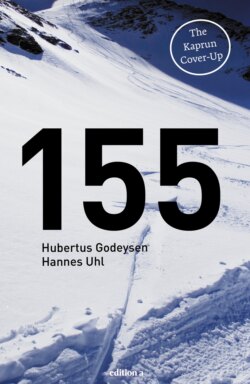Читать книгу 155 - Hubertus Godeysen - Страница 14
На сайте Литреса книга снята с продажи.
Chapter 9
ОглавлениеFranz Lang is in the shower at 9:25 when he gets word of the fire in Kaprun. It’s Saturday, and he’s off for the weekend from his job as head of the criminal department of the Salzburg state police. Three days before his forty-second birthday, he could do without a surprise like this. But now every second counts.
For a catastrophe on this scale, he is the default head of operations, overseeing all the emergency responders, supporting staff, and investigators. He rushes to Kaprun in his wife’s car with a portable blue light on the roof. On the way, he hears everyone’s worst fears confirmed on the radio news: up to 180 skiers are trapped.
Lang phones the Ministry of the Interior in Vienna and requests support. For a fire disaster like this one, the fire investigators of the Forensic Central Unit (in German, the Kriminaltechnische Zentralstelle or KTZ)1 in Vienna are responsible. Their job is to preserve evidence, investigate, and examine witnesses. They report to the Ministry of the Interior led by Ernst Strasser. Lang is told the investigators will prepare for immediate deployment and make their way to Kaprun as soon as possible.
As he drives through Bruckberg, a neighborhood of Zell am See, Lang’s gaze is drawn immediately to the Kitzsteinhorn. It stands majestically in the distance, the 3203-meter-high mountain with a razor-sharp ridge curving towards the Salzach valley. To the right of the ridge are rugged expanses of rock and the gleaming white glacier with its lift systems and the world’s highest cable-car mast. Just one detail disturbs the picture-perfect scene: the smoke still issuing from the Alpincenter.
Upon arriving at the site of the catastrophe, police major Lang demonstrates his management skills. They are what’s needed now. He starts by trying to coordinate the rescue operation, holding one meeting after another and getting all relevant parties – the fire department, mountain rescuers, and paramedics, as well as the operations manager2 and technical director of the glacier railway – around one table.
From the men of the Kaprun volunteer fire department, he learns what the inside of the tunnel looks like and that they don’t expect to find survivors. However, as long as there’s any doubt, Lang allows the rescue operation to continue. He divides the disaster site, which stretches almost four kilometers from the valley station through the tunnel, into three sections. The first is the valley station, including the tunnel entrance and the helicopter landing area; the second is the Breitriesen side tunnel, leading to the middle of the train tunnel, and the third is the mountain station, where the smoke from the tunnel is the only perceptible sign of the catastrophe.
Some first responders take the helicopter to the Breitriesenalpe, where there’s a hunter’s cabin halfway to the ski area. Their plan is to press forward over the 638-meter-long side tunnel to the middle station in the main tunnel and on to the location of the fire. But it soon becomes obvious that the side tunnel is filled with smoke. By 1:00 pm, they’ve assembled enough equipment for an investigative team carrying respiratory gear with up to four hours of breathable air to make their way into the tunnel.
With more than 800 meters to the train, the way down is arduous, nearly 2400 steps. It’s dark and smoky in the tunnel. The emergency responders proceed with great care to avoid falling. After 650 meters, they encounter the first casualty: a boy, 13 or 14 years old.
Their descent continues in the same vein, a terrible, grisly walk for the firefighters: one dead body after another for more than 100 meters. They either came to rest on the emergency stairs or fell into the track bed. The firemen also see mothers and fathers who tried to cover their children with their bodies as they succumbed to death.
At 60 casualties, they stop counting, but they haven’t yet reached their goal. There are just too many victims. When they arrive at the burnt-out train, they can’t believe their eyes. So many bodies are lying in front of the train, side-by-side and on top of each other, that the track bed and rails are completely hidden.
The men make their way past the burnt-out train, stepping over the corpses lying around the front end. It’s impossible to enter the train, which has burned down to its steel frame, because it’s still glowing. At 3:30 pm, they reach the lower end of the tunnel after almost three hours inside.
By now it’s clear to all of them that no hope remains for a miracle in Kaprun, no rescue from a desperate situation. Everyone who fled upwards was killed by the poisonous gases. Everyone in the tunnel is dead.
